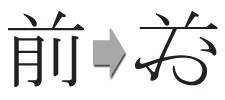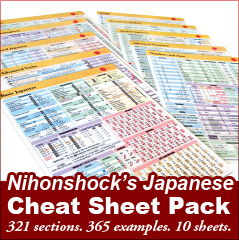Shorthand Kanji Forms
Shorthand kanji forms (called
But longtime readers of Nihonshock by now have probably figured out that I love learning and exploring all of these you-don’t-really-need-to-know-this-but… areas of Japanese. After all, if you’re in Japan long enough, sooner or later you will come across them.
Where are shorthand kanji used?
By their nature, they can only be used in hand-written Japanese (you can’t even get most of the shorthand forms to appear on a computer). And since they’re considered incorrect forms, you’ll find them mostly in extremely casual correspondence or in note-to-self types of writing.
The primary reason to use them is for speed. As a learner, I’m sure you know that writing kanji can be a time consuming process. The Japanese are well-practiced and can write it significantly faster than most of us gaijin, but still have the same problem. Many (most?) kanji are just plain inefficient.
So who might benefit from the ability to write things quickly? That’s right, a student! Taking lecture notes is a situation just begging for writing shortcuts. And as you will see, many of the less mainstream shorthand kanji are ones that would be useful in exactly that situation.
But first, let’s start with some of the most major/useful shorthand forms:




Obviously, all of these kanji save the writer quite a bit of time, effort and ink.
The reduced form of
The reduced form of 曜 is a personal favorite of mine, although surprisingly not as frequently used by Japanese as some of the other shorthand forms. Beginners to Japanese know (and fear) this kanji well, as it’s the most difficult one that you have to learn at their level. The problem is how commonly the kanji is needed; it’s used in all the words representing a day of the week (for example: Monday =
The shorthand for




The shorthand for
The image of the shorthand for
㐂 is actually is actually not a reduction of the original kanji
The shorthand for


These are a couple of my favorites. The kanji
The word for library (
Combining kana with kanji




These are some examples of using katakana for certain elements of a kanji. They’re not exactly standardized, but the basic concept is still a great way for anyone to invent a shorthand on the fly. Usually, the katakana is based on the reading of the kanji.
As to why the shorthand for ![]()
Shorthand kanji in specialized fields




It makes sense that if there’s a particular difficult kanji that you have to write a lot, you’re more likely to create or use a shorthand for it. The above kanji show instances where this has happened. None of these a really for general consumption but…
If you’re a chemist, you might like to use the shorthand form of 濾, which is used in words such as
The last one is a convenient shorthand used by some residents of Niigata (
Conclusion
Shorthand kanji are an interesting and potentially useful tool for anyone who has to actually hand-write Japanese. I just hope you won’t try to use them on your Japanese tests, job applications in any other context where you really should be writing “correctly.”
If you liked this post and want to know more about shorthand kanji, check out the wikipedia article, and here’s a nice shorthand compilation on a Japanese-language site. Also, I’ve compiled all of these and more shorthand forms on the Kanji Cheat Sheet which is a part of Nihonshock.com’s Japanese Cheat Sheet Pack. Click the link for more info.
On a side note, I even used some kanji as shorthand in my English note-taking when I was in college. Writing ![]()








[…] is a really interesting article on Japanese shorthand from the website Nihonshock. Kanji’s are transformed using a combination […]